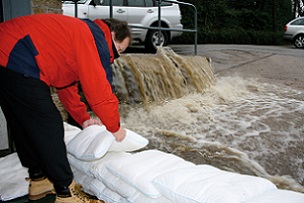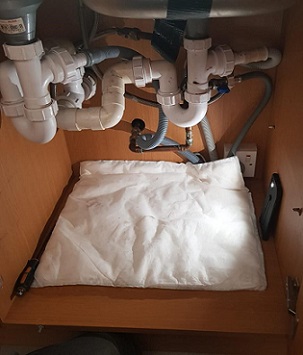 Mary Long-Dhonau who is known as Mary Queen of Floods
Mary Long-Dhonau who is known as Mary Queen of Floods
 Traditional sandbags are notorious for letting floodwater seep through them
Traditional sandbags are notorious for letting floodwater seep through them
 FloodSax alternative sandbags holding back a torrent of floodwater
FloodSax alternative sandbags holding back a torrent of floodwater
 FloodSax can also be used inside to soak up leaks in hard-to-reach places
FloodSax can also be used inside to soak up leaks in hard-to-reach places
Flood expert explains why sandbags don’t work to keep floodwater out of homes and businesses
Traditional sandbags are poor at holding back water and sand escaping from them can make the situation even worse by clogging up drains.
These are the views of flood resilience campaigner and consumer champion Mary Long-Dhonau who says sandbags should no longer be used to prevent floods.
For over 20 years, Mary – who is affectionately known as Mary Queen of Floods and is the voice of the Know Your Flood Risk Campaign – has been supporting communities that are at risk of flooding by providing support and advice about anti-flooding products that are way better than sandbags.
She said: “Whenever a flood is imminent everyone at risk calls for the humble, inefficient and environmentally-unfriendly sandbag which I consider to be no more than a ‘comfort blanket’ when a flood emergency happens.
“In a recent test at an accredited British Standard Institute testing tank, four sandbags placed in front of a household door failed after just 59 seconds of the water being turned on while 10 sandbags held water back for just over two minutes.
“Furthermore, the sand that escaped from the bag badly blocked the sump pump used to drain the water out of the testing tank. This also happens in real flood conditions and sand often collects in drains, rendering them inefficient come the next heavy rainfall.
“Sandbags do more harm than good and it frustrates and upsets me to see them continually being used as a go-to solution when they simply don’t work.”
Sir Michael Pitt’s review into the extensive floods of 2007 was unable to find any real evidence that sandbags were particularly effective in safeguarding households. Nevertheless, 15 years on and sandbags are still widely regarded as an important focus for community action.
Mary, who travels the country in a special Floodmobile giving advice on a range of anti-flooding measures, added: “The general provision of sandbags should be phased out in favour of proven products. Sandbags do little more than filter flood water. They are time consuming to fill and put in situ, are not easy to store, quickly become contaminated by filthy flood water rendering them completely unusable and are a challenge to dispose of.”
Many people don’t realise that local councils have no responsibility to provide sandbags so people have to organise their own flood protection.
One alternative is FloodSax sandless sandbags and Mary said: "When travelling around in the Floodmobile I always recommend FloodSax as party of the property level flood risk management toolkit."
FloodSax are vacuum-packed in packs of five in easy to carry bags and four packs fit into one cardboard box weighing just 21lbs (9.5kilos)– that’s the equivalent to 20 traditional sandbags and imagine trying to lift and shift them to both store and then putting them in place when a flood is about to happen.
To deploy FloodSax as alternative sandbags when a flood is forecast or is actually happening, simply immerse the FloodSax in 20 litres of water in a large bucket or tub. You could even use a hosepipe or, if time is really critical, the floodwater itself.
The FloodSax will then expand in around 8 minutes to weigh 20kg (44lbs). A special gelling polymer inside simply absorbs the water and then keeps it in the FloodSax so it can be used for however long the emergency lasts, which could be several months.
Each row of FloodSax will keep out approximately 7 inches of water and usually two or three rows are enough to keep floodwater out.
FloodSax are flexible – in their dry state they can be used inside to soak up leaks, drips and floods in hard-to-reach places such as beneath pipes and even floorboards.
To learn more about Property Flood Resilience, Mary Long-Dhonau has co-authored several guides including the Homeowners Guide to Flood Resilience and a Property Flood Resilience eBook. Both are free and available to download at https://marydhonau.com/